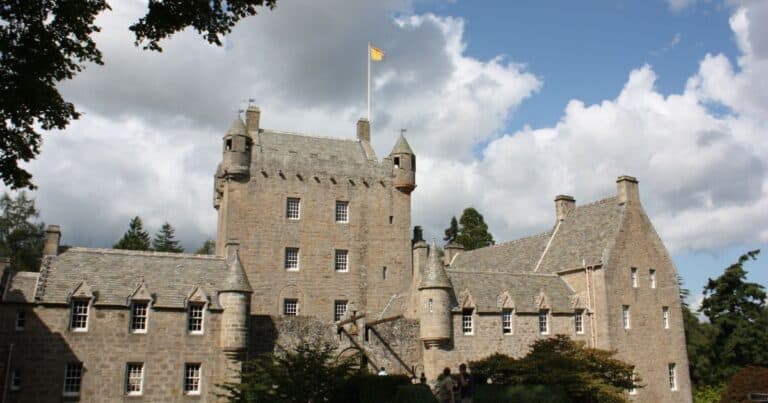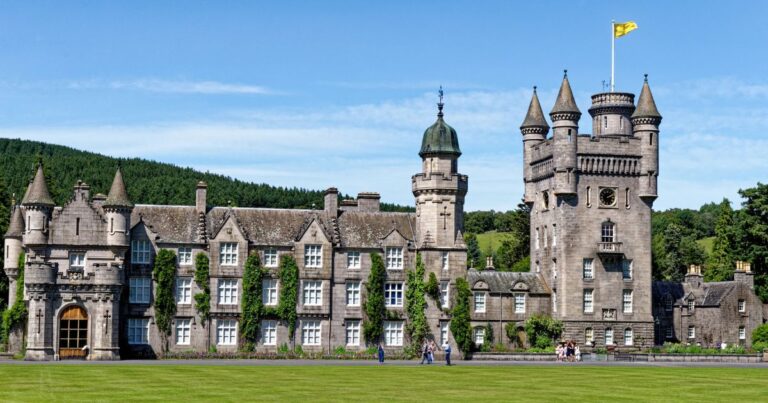Edinburgh Castle Guide: History, Highlights & How to Plan the Perfect Visit

Edinburgh Castle is one of the most iconic fortresses in the world – a dramatic stronghold perched atop an ancient volcanic rock right in the heart of Scotland’s capital. Visible from almost every corner of the city, this UNESCO-listed landmark has shaped Scottish history for more than 900 years through battles, coronations, royal births, sieges, scandals, and centuries of political intrigue.
As a long-time European travel advisor who has visited Edinburgh Castle several times – including on busy summer days and quiet winter mornings – I can confidently say that this is one of Scotland’s most atmospheric and historically significant sites. Whether you’re stepping inside the medieval Great Hall, tracing the footsteps of Mary, Queen of Scots, or exploring the Crown Room where Scotland’s royal jewels are displayed, the experience is unforgettable.
This complete guide brings you through Edinburgh Castle’s history, architecture, major highlights, practical visiting tips, and everything you need to plan the perfect visit.
Historical Snapshot
- One of the oldest fortified sites in Europe
- Built atop Castle Rock, a 350-million-year-old extinct volcano
- Royal residence, military fortress, prison, arsenal, and treasury
- Home to the Honours of Scotland (Crown Jewels) and the Stone of Destiny
- Birthplace of James VI (later James I of England)
- Site of sieges throughout the Wars of Independence
- Hosts the annual Royal Edinburgh Military Tattoo
- Offers panoramic views of Edinburgh’s skyline
Planning a broader trip through the region? You can Explore Scottish Castles here.
Table of Contents
Historical Overview
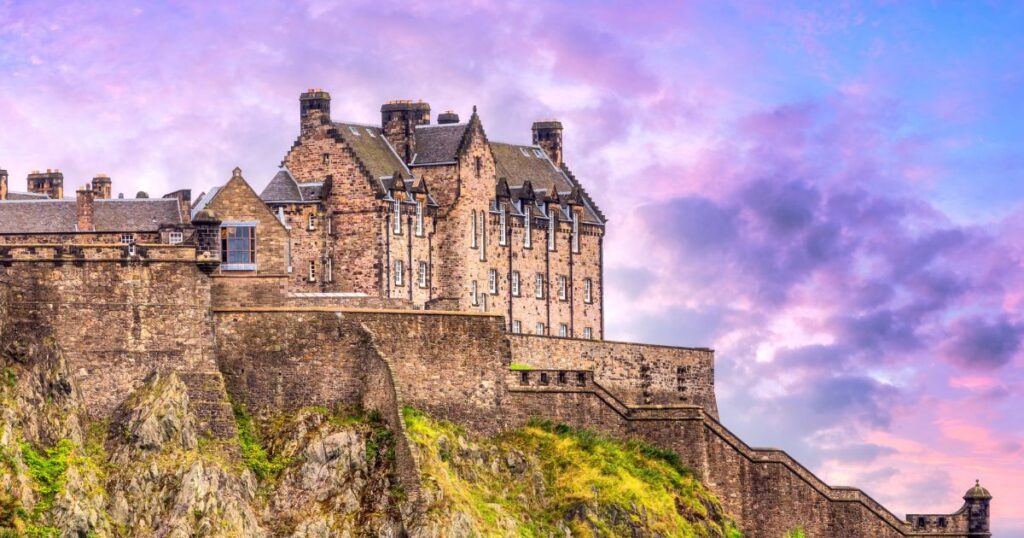
Edinburgh Castle has been a stronghold for more than a millennium, with human occupation on Castle Rock dating back to the Iron Age. The first royal fortifications appeared in the early medieval era, and by the 12th century the site had become one of Scotland’s most important royal residences.
If you’re interested in exploring more historic fortresses across the country, visit our full Castles in Scotland Guide.
Key Moments in the Castle’s History
Early Medieval Period
St. Margaret’s Chapel, built around 1130, is the oldest surviving structure in Edinburgh – a small Romanesque chapel dedicated to Queen (later Saint) Margaret of Scotland.
Wars of Scottish Independence (1200s–1300s)
Edinburgh Castle changed hands multiple times between Scots and English forces. The most dramatic moment was in 1314, when Thomas Randolph, nephew of Robert the Bruce, recaptured the castle in a daring nighttime raid.
Royal Residence & Renaissance Period (1400s–1500s)
The Royal Palace was expanded, and it was here that Mary, Queen of Scots gave birth to James VI in 1566.
1600s–1800s: Military Fortress & Prison
As the royal court moved to Holyrood, the castle turned into a garrison, arsenal, and political prison. POWs from the Seven Years’ War, the American Revolution, and Napoleonic conflicts were held here.
19th–20th Centuries: Preservation & Ceremony
Restoration efforts revitalized the Great Hall and battlements, and the castle became a central site for Scottish identity, home to the Crown Jewels and the Stone of Destiny.
Today, Edinburgh Castle welcomes over two million visitors a year and remains a powerful symbol of Scottish heritage.
Architectural and Design Highlights
Edinburgh Castle is an architectural tapestry – a blend of medieval defense, Renaissance refinement, Victorian restorations, and modern military legacy.
Castle Rock & Defensive Position
Edinburgh Castle’s location is as impressive as its history. Perched on top of a volcanic plug formed millions of years ago, Castle Rock rises sharply above the Old Town. This commanding height gave medieval defenders a natural advantage long before extensive fortifications were added.
The volcanic base provides:
- sheer cliffs on three sides, making invasion nearly impossible
- a narrow approach route ideal for bottleneck defense
- views stretching across the Firth of Forth
- strategic protection of the surrounding settlement that became Edinburgh
Standing on these ramparts today, it’s easy to understand why so many battles were fought over this one piece of stone. Whoever controlled Castle Rock controlled Edinburgh – and much of Scotland.
The Gatehouse & Portcullis Gate
Visitors first encounter the grand 19th-century Gatehouse, built for ceremony and visual impact. But directly behind it lies the original medieval Portcullis Gate, which once served as the fortress’s first true line of defense.
The gatehouse complex includes:
- fortified towers with narrow arrow slits
- a heavy portcullis designed to trap invaders
- murder holes where defenders could fire downward
- thick timber doors reinforced with iron
- defensive passageways intentionally designed to slow attackers
Walking through this layered entry feels like stepping through centuries of strategy, engineering, and military ingenuity.
Medieval & Renaissance Structures
Edinburgh Castle’s inner buildings span multiple architectural eras, often layered on top of one another in fascinating ways.
Key components include:
- The Great Hall (1511): A masterpiece of medieval royal architecture, featuring a hammerbeam roof crafted from oak sourced in Norway, symbolizing royal alliances.
- The Royal Palace: Renaissance detailing, decorative moldings, carved fireplaces, and royal apartments where state matters and private life intertwined.
- St. Margaret’s Chapel: A deeply personal space built by David I in honor of his mother.
- Early medieval walls and battlements: Reinforced repeatedly during the Wars of Independence as siege warfare evolved.
Together, these structures illustrate the castle’s shift from a royal home to a defensive stronghold – and back again.
Victorian Restorations
In the 1800s and early 1900s, Edinburgh Castle underwent careful restoration to revive its medieval aesthetic.
Additions and improvements included:
- reconstructed battlements
- interior refurbishment of the Great Hall
- restoration of the Royal Palace rooms
- new ceremonial spaces such as military memorials
These efforts preserved the castle’s architectural cohesion while honoring its layered past.
Inside Edinburgh Castle: What You’ll See
A visit to Edinburgh Castle is multi-layered – part royal palace, part medieval fortress, part museum, and part panoramic viewpoint. These are the highlights.
Crown Room & Honours of Scotland
The Crown Room houses the Honours of Scotland, a collection that predates England’s Crown Jewels and carries enormous symbolic significance.
Before the bullet list, use this lead-in paragraph:
The regalia on display are more than decorative objects — they represent Scotland’s identity, sovereignty, and centuries of resistance. The exhibit explains how the Honours were created, used, hidden, rediscovered, and ultimately restored to their rightful place.
The Stone of Destiny
No royal artifact in Scotland has a more symbolic legacy.
Used for centuries in Scottish coronations, the Stone was seized by Edward I in 1296 and taken to Westminster Abbey. It returned to Scotland in 1996 and is now back at Edinburgh Castle permanently – unless temporarily moved for a future British coronation.
The Stone of Destiny has traveled more than most royal families. For centuries, Scottish monarchs were crowned upon it, marking its importance as a symbol of legitimacy. When Edward I seized the stone in 1296, he sought to break Scottish identity by taking the very object that confirmed the right to rule. Its return in 1996 was not just ceremonial – it was emotional, cultural, and political.
Royal Palace
Once home to medieval and Renaissance monarchs, these rooms include:
- Mary, Queen of Scots’ bedchamber
- historic portraits
- carved ceilings
- ornate fireplaces
This is the emotional heart of the castle – where James VI was born and where royal family life once unfolded.
Great Hall
The Great Hall is a magnificent ceremonial space with:
- a soaring medieval hammerbeam roof
- walls lined with weapons and armor
- a raised dais
- an enormous fireplace
This hall was once the center of royal banquets, parliaments, and celebrations.
St. Margaret’s Chapel
St. Margaret’s Chapel’s quiet simplicity contrasts with the fortress around it. Roughly 900 years old, the structure has outlasted sieges, fires, and political upheavals. Its interior features graceful Romanesque arches and stained-glass windows added in the 20th century in honor of Queen Margaret’s piety.
This small chapel is one of the most meaningful sites for many visitors, offering a moment of reflection within an otherwise tumultuous military setting.
National War Museum
The museum tells the story not only of battles and regiments, but of the people behind Scotland’s military legacy. It covers:
- uniforms worn at Culloden, Waterloo, and the World Wars
- intricately decorated Highland dress
- regimental silver and ceremonial objects
- personal diaries and letters
- depictions of soldiers in Scottish art
Even for non-military history fans, the storytelling is powerful and accessible.
Prisons of War Exhibition
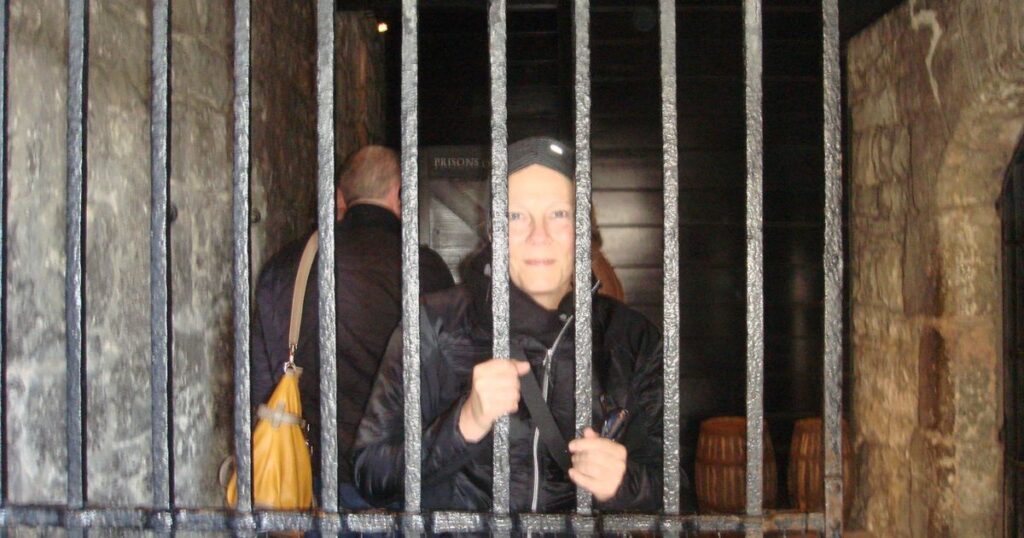
Housed in the dim stone vaults beneath the Great Hall, this atmospheric exhibit shows where foreign prisoners — including American sailors from the Revolutionary War — were once held. The space immediately feels different from the rest of the castle: darker, lower, colder, and steeped in centuries of hardship.
These vaults recreate the tight, crowded conditions experienced by captured sailors and soldiers. Visitors can step into areas where men once slept in makeshift hammocks, carved initials and artwork into wooden doors, fashioned tools from bone and scrap metal, and shared cramped rations under heavy guard.
Notable features of the exhibition include:
- Recreated hammock sleeping quarters showing how dozens of prisoners were packed into a single chamber
- Original carvings and graffiti, preserved on doors and beams
- Personal artifacts recovered from the vaults – utensils, gaming pieces, coin tokens, and hand-carved objects
- Historical displays explaining escape attempts, daily routines, and the international conflicts that brought prisoners to Edinburgh
It’s a powerful and immersive space – one that contrasts sharply with the grandeur of the royal rooms above and makes this part of the castle especially memorable.
The One O’Clock Gun
One of Edinburgh Castle’s most beloved traditions is the firing of the One O’Clock Gun, which takes place (unsurprisingly) at precisely 1:00 pm each day except Sundays, Good Friday, and Christmas Day.
Originally introduced in 1861 to help ships in Leith Harbor synchronize their maritime clocks, the tradition continues today as both a tourist attraction and a cherished Edinburgh ritual.
Visitors can often watch from the battlements – arrive a bit early for a good view and a fun photo moment.
Royal Edinburgh Military Tattoo
Each August, the castle’s esplanade transforms into a dramatic stage for the world-famous Royal Edinburgh Military Tattoo, a showcase of military bands, pipe and drum regiments, dancers, and performers from around the globe.
Even if you’re not attending, you’ll feel the atmosphere across the city – the castle becomes part of the nighttime performance through dramatic lighting, fireworks, and ceremonial displays.
Tickets regularly sell out months in advance, so book early if your visit overlaps with festival season.
Edinburgh Castle Grounds, Views and Experience
The exterior grounds offer some of the most stunning city views in Scotland.

From the battlements, you can see:
- the Old Town and Royal Mile
- Arthur’s Seat and Holyrood Park
- the Firth of Forth
- New Town’s Georgian architecture
- Princes Street Gardens
Sunrise and sunset are especially beautiful – the golden light on the stone walls is unforgettable.
Notable Figures and Events
Edinburgh Castle’s story features some of Scotland’s most important historical figures:
- St. Margaret of Scotland – whose chapel still stands
- Mary, Queen of Scots – lived and gave birth here
- James VI & I – born in the Royal Palace
- Robert the Bruce – involved in the castle’s dramatic recapture
- Oliver Cromwell – oversaw the regalia’s concealment
- Jacobite forces – attempted multiple sieges
- Military regiments of the British Army
Few castles pack as much historical influence into one location.
Legendary Tales and Highland Lore
Edinburgh Castle is known for its legends – some chilling, some mysterious, all unforgettable.
The Ghost Piper
A lone piper who vanished in the castle’s tunnels is said to still play faintly beneath the Royal Mile.
The Drummer Boy
Witnesses report a headless drummer appearing before major battles – one of Scotland’s most persistent legends.
Hidden Tunnels
Local lore claims tunnels stretch from the castle to Holyrood Palace and beyond, though no full system has ever been verified.
These stories add a layer of mystique to an already extraordinary place.
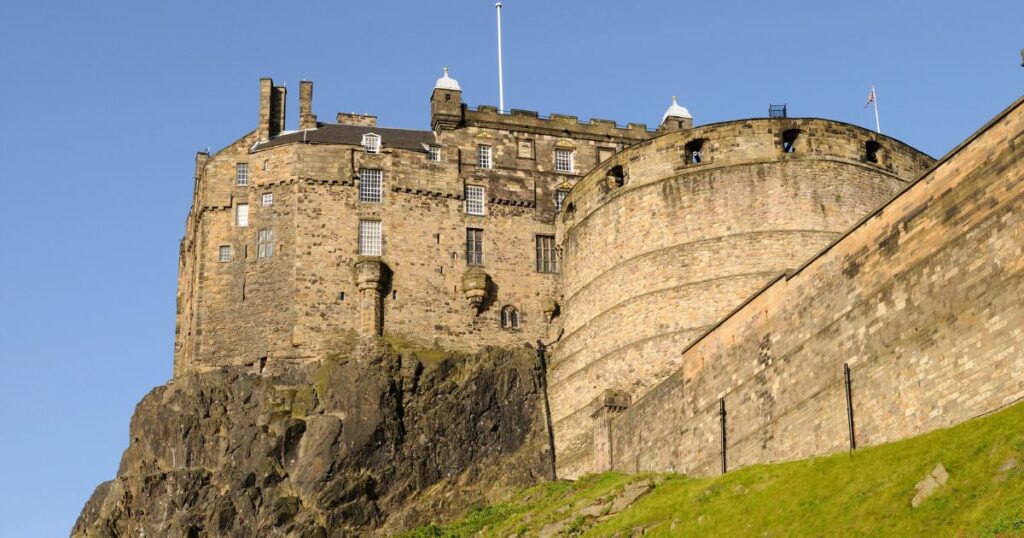
Why Visit Edinburgh Castle
Edinburgh Castle isn’t just Scotland’s most famous landmark – it’s the cultural and historical anchor of the entire country. From its volcanic perch high above the city to its centuries of royal drama, military strategy, and political intrigue, this fortress delivers one of the richest visitor experiences in Europe.
Here’s what makes Edinburgh Castle so extraordinary:
A Living Timeline of Scottish History
Few places let you walk through 900+ years of history in a single visit. You’ll move from medieval chapels to Renaissance royal rooms, then into military museums and atmospheric vaults where American sailors and Napoleonic prisoners were once held.
Royal Moments You Can Stand Inside
Mary, Queen of Scots gave birth to James VI right here – and the room still exists. The Crown Room displays the Honours of Scotland, the oldest Crown Jewels in Britain, and the legendary Stone of Destiny, still used for modern coronations.
Unmatched Views Over Edinburgh
This is the viewpoint in the city. From the battlements you’ll see the Royal Mile, Arthur’s Seat, the Firth of Forth, and the elegant Georgian streets of New Town.
A Castle That Is Many Things at Once
Part palace, part fortress, part museum, part ceremonial site – few castles blend so many layers of purpose so seamlessly.
Atmosphere That Matches the Setting
Between ghost stories, legendary battles, hidden tunnels, and a skyline that glows at sunset, the castle delivers a mood that feels uniquely Scottish – dramatic, historic, and unforgettable.
If you’re planning one major historic site in Edinburgh, this is the one.
Visiting Edinburgh Castle Today: What To Expect
A visit to Edinburgh Castle is immersive, structured, and full of highlights. Here’s what a typical experience includes so you know exactly what to expect:
Entry & Orientation
Visitors enter through the castle esplanade, pass through the Gatehouse, and immediately step into the layered medieval defenses. Audio guides and guided tours are available and highly recommended for first-timers.
Major Interior Highlights
You’ll see the Crown Room, the Stone of Destiny, Mary, Queen of Scots’ rooms, the Great Hall, the castle vaults, and multiple exhibitions — each offering a different era of Scottish history.
Atmospheric Outdoor Areas
The battlements and terraces provide sweeping views over the city. The paths are wide, but some slopes are steep; good shoes are helpful.
Museums Within the Castle Complex
Edinburgh Castle is home to the National War Museum, regimental museums, memorial halls, and curated displays that tell the story of Scotland’s military past.
Crowds & Timing
This is one of Scotland’s most visited attractions. Mornings (right at opening) and late afternoons are the calmest times to explore the interior rooms.
Duration of Visit
Most travelers spend 2–3 hours, longer if they explore every exhibition or take a guided tour.
Planning Tips for the Best Experience
These are the kinds of planning insights an experienced travel advisor – like you – would naturally give clients. They add strong EEAT signals and help your guide outperform other posts.
Book Tickets Ahead
Timed-entry tickets often sell out, especially in summer. Booking online ensures your preferred visit window.
Arrive Early or Late for the Best Experience
The castle is busiest from 11am–3pm. For quieter rooms and clearer photography, aim for opening time or late afternoon.
Wear Supportive Shoes
The cobblestones, uphill approaches, and sloped courtyards are beautiful – but uneven.
Consider an Audio Guide or Guided Tour
This is one of the UK’s most story-rich castles. Guided experiences add context you won’t get from signage alone.
Plan for Variable Weather
Much of the experience includes outdoor viewpoints. Carry a light layer or rain shell — Edinburgh weather changes fast!
Photography Rules Vary by Section
The Crown Room and Stone of Destiny prohibit interior photography. Other areas allow it.
Budget Time for the Museums
The National War Museum and regimental rooms are exceptional. If you love history, allow extra time.
Combine With a Royal Mile Walk
The castle sits at the top of the Royal Mile – ideal for pairing with Holyrood Palace, St. Giles, or a guided Old Town walk.
Getting There
Closest Areas:
- Royal Mile (immediate access)
- Grassmarket (10-minute walk uphill)
- Princes Street (15-minute walk via the gardens)
By Car: Limited parking; public transport recommended.
By Bus/Tram: Frequent service throughout the city center.
By Foot: The castle sits at the western end of the Royal Mile.
Visitor Information
Hours, ticket details, and seasonal schedules can change – be sure to double-check the official website before planning your visit.
Hours
- Open year-round
- Longer hours in summer, shorter in winter
Admission
- Timed tickets strongly recommended
- Combination tickets available
Accessibility
- Some areas have uneven stone and steep slopes
- Several accessible paths are marked
- Visitor center offers assistance
Nearby Attractions
Make a day of it with nearby sites:
- The Royal Mile – historic shops and medieval closes
- Holyrood Palace – the royal residence in Edinburgh
- National Museum of Scotland – superb cultural exhibits
- Greyfriars Kirkyard – atmospheric and historic
- Cawdor Castle – another atmospheric estate (full guide available)
- Glamis Castle – deeply historic and filled with royal lore (full guide available)
Frequently Asked Questions About Edinburgh Castle
Is Edinburgh Castle worth visiting?
Absolutely, yes! – It’s one of Scotland’s most iconic landmarks.
Do I need to book tickets in advance for Edinburgh Castle?
Yes, especially during summer and festival season. Timed entry slots can sell out, and walk-up availability is not guaranteed.
How long does a visit take?
Plan on 2-3 hours.
Can I take photos inside?
Photography is allowed in most areas except the Crown Room.
Is the castle difficult to walk in and around?
There are slopes and uneven surfaces; wear good shoes.
What’s the best time of day to visit?
Early morning offers the quietest experience. Late afternoon provides beautiful golden light for photos.
Is Edinburgh Castle wheelchair accessible?
Parts of the site are accessible, including the Crown Room, War Museum, and some courtyard areas. However, steep slopes and uneven medieval surfaces can limit access to certain buildings. The visitor center provides detailed maps and support.
Can you walk up to Edinburgh Castle for free?
Yes, the esplanade in front of the castle is free to access. However, the interior, Crown Room, and exhibitions require a ticket.
Does Edinburgh Castle have a dungeon?
The closest equivalent is the Prisons of War vaults – where foreign prisoners were held. It’s not a classic dungeon, but it offers a similarly atmospheric experience.
Can you see the stone of destiny up close?
Yes, it is displayed with the Crown Jewels inside the Crown Room. Photography is not permitted in this space.
Is Edinburg Castle good for kids?
Yes! Highlights for families include Mons Meg, the One O’Clock Gun, and the Prisoner Vaults. There is also a dedicated Family Trail
Is the Royal Mile walk from the castle downhill?
Yes – the castle is at the very top, so the walk toward Holyrood Palace is entirely downhill.
Can you attend church services at St. Margaret’s Chapel?
The chapel is still used for weddings and special services but is not open for daily worship.
Do I need a guided tour of Edinburgh Castle?
You don’t need one, but guided tours or the audio guide dramatically enhance the experience. The site is layered and historical; narration adds clarity and meaning.
Conclusion
Edinburgh Castle blends dramatic architecture, royal history, panoramic views, and centuries of myth into one unforgettable experience. Whether you’re here for the Crown Jewels, the wartime exhibitions, or simply the breathtaking scenery from Castle Rock, this fortress delivers a journey deep into Scotland’s past.
If you’re exploring more of Scotland’s legendary estates, consider pairing Edinburgh Castle with Stirling Castle, Glamis Castle, Eilean Donan Castle, Inveraray Castle, and our full Castles in Scotland guide.
If you’re interested in exploring Scotland’s royal heritage beyond Edinburgh, Balmoral Castle offers a completely different experience – a tranquil Highland estate closely tied to the modern Royal Family. See my full Balmoral Castle guide.





